engine TOYOTA CAMRY 2016 XV50 / 9.G Quick Reference Guide
[x] Cancel search | Manufacturer: TOYOTA, Model Year: 2016, Model line: CAMRY, Model: TOYOTA CAMRY 2016 XV50 / 9.GPages: 48, PDF Size: 1.46 MB
Page 3 of 48
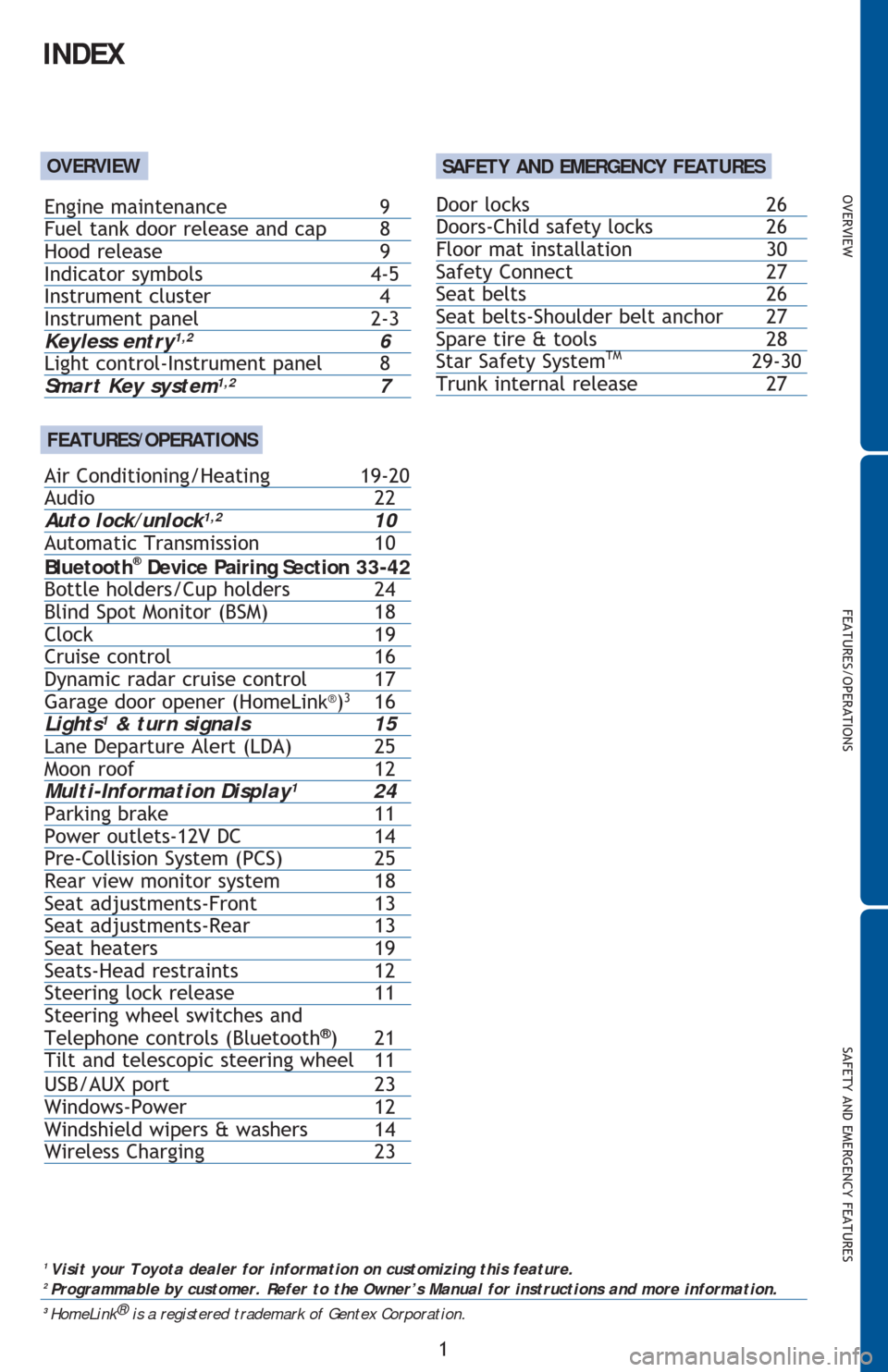
OVERVIEW
FEATURES/OPERATIONS
SAFETY AND EMERGENCY FEATURES
1
INDEX
1
Visit your Toyota dealer for information on customizing this feature.2 Programmable by customer. Refer to the Owner’s Manual for instructions and more information.3
HomeLink®
is a registered trademark of Gentex Corporation.
OVERVIEW
FEATURES/OPERATIONS
Door locks 26
Doors-Child safety locks 26
Floor mat installation 30
Safety Connect 27
Seat belts 26
Seat belts-Shoulder belt anchor 27
Spare tire & tools 28
Star Safety System
TM 29-30
Trunk internal release 27
Engine maintenance 9
Fuel tank door release and cap 8
Hood release 9
Indicator symbols 4-5
Instrument cluster 4
Instrument panel
2-3Keyless entry1,2 6
Light control-Instrument panel 8
Smart Key system1,2 7
Air Conditioning/Heating 19-20
Audio 22
Auto lock/unlock
1,2 10
Automatic Transmission 10
Bluetooth
® Device Pairing Section 33-42
Bottle holders/Cup holders 24
Blind Spot Monitor (BSM) 18
Clock 19
Cruise control 16
Dynamic radar cruise control 17
Garage door opener (HomeLin
k®)3
16
Light
s1 & turn signals 15
Lane Departure Alert (LDA) 25
Moon roof 12
Multi-Information Display
1 24
Parking brake 11
Power outlets-12V DC 14
Pre-Collision System (PCS) 25
Rear view monitor system 18
Seat adjustments-Front 13
Seat adjustments-Rear 13
Seat heaters 19
Seats-Head restraints 12
Steering lock release 11
Steering wheel switches and
Telephone controls (Bluetooth
®) 21
Tilt and telescopic steering wheel 11
USB/AUX port 23
Windows-Power 12
Windshield wipers & washers 14
Wireless Charging 23
SAFETY AND EMERGENCY FEATURES
Page 4 of 48
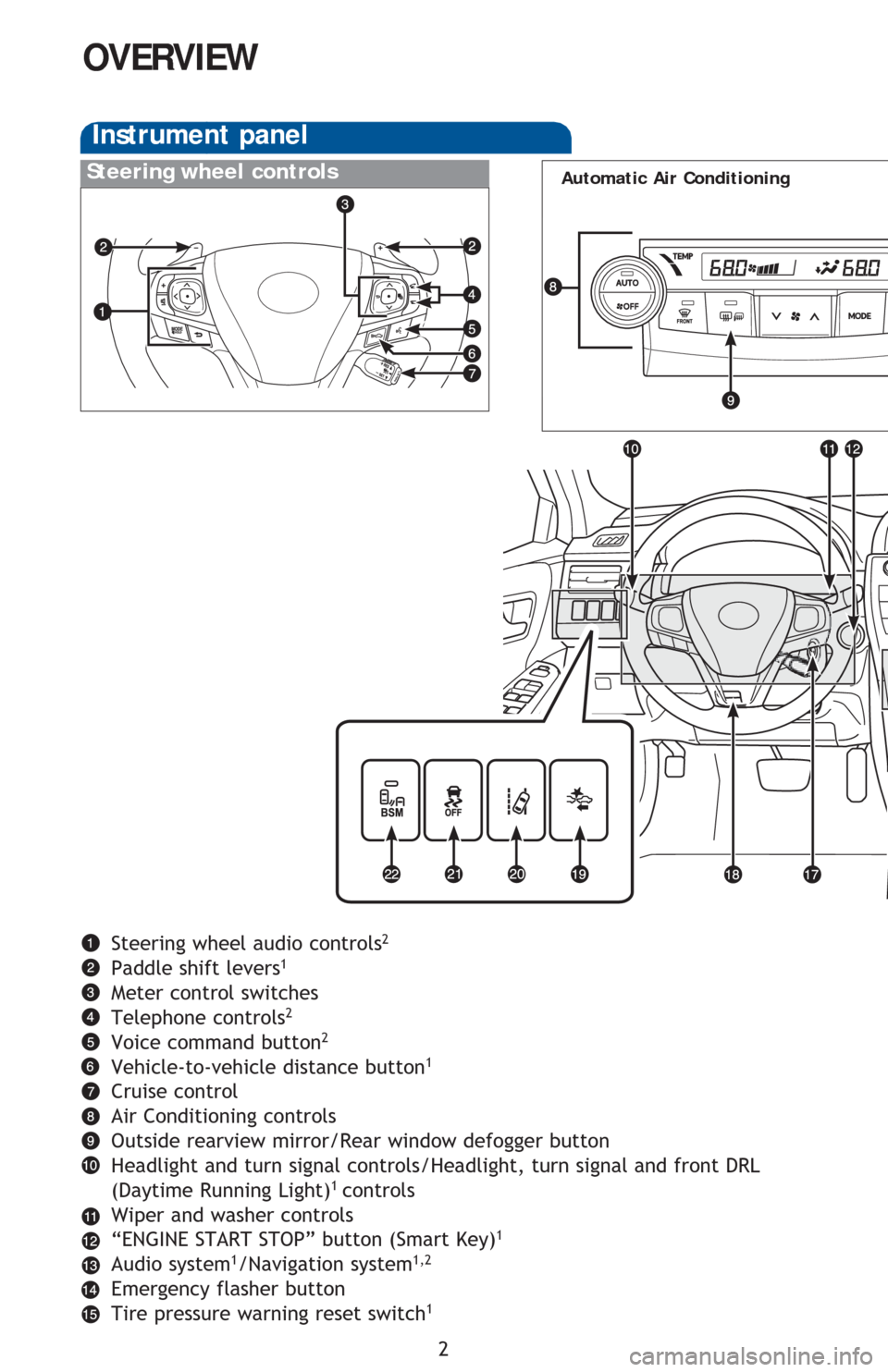
2
OVERVIEW
Instrument panel
Steering wheel audio controls2
Paddle shift levers1
Meter control switches
Telephone controls2
Voice command button2
Vehicle-to-vehicle distance button1
Cruise control
Air Conditioning controls
Outside rearview mirror/Rear window defogger button
Headlight and turn signal controls/Headlight, turn signal and front DRL
(Daytime Running Light)
1 controls
Wiper and washer controls
“ENGINE START STOP” button (Smart Key)
1
Audio system1/Navigation system1,2
Emergency flasher button
Tire pressure warning reset switch1
Steering wheel controlsAutomatic Air Conditioning
Page 6 of 48
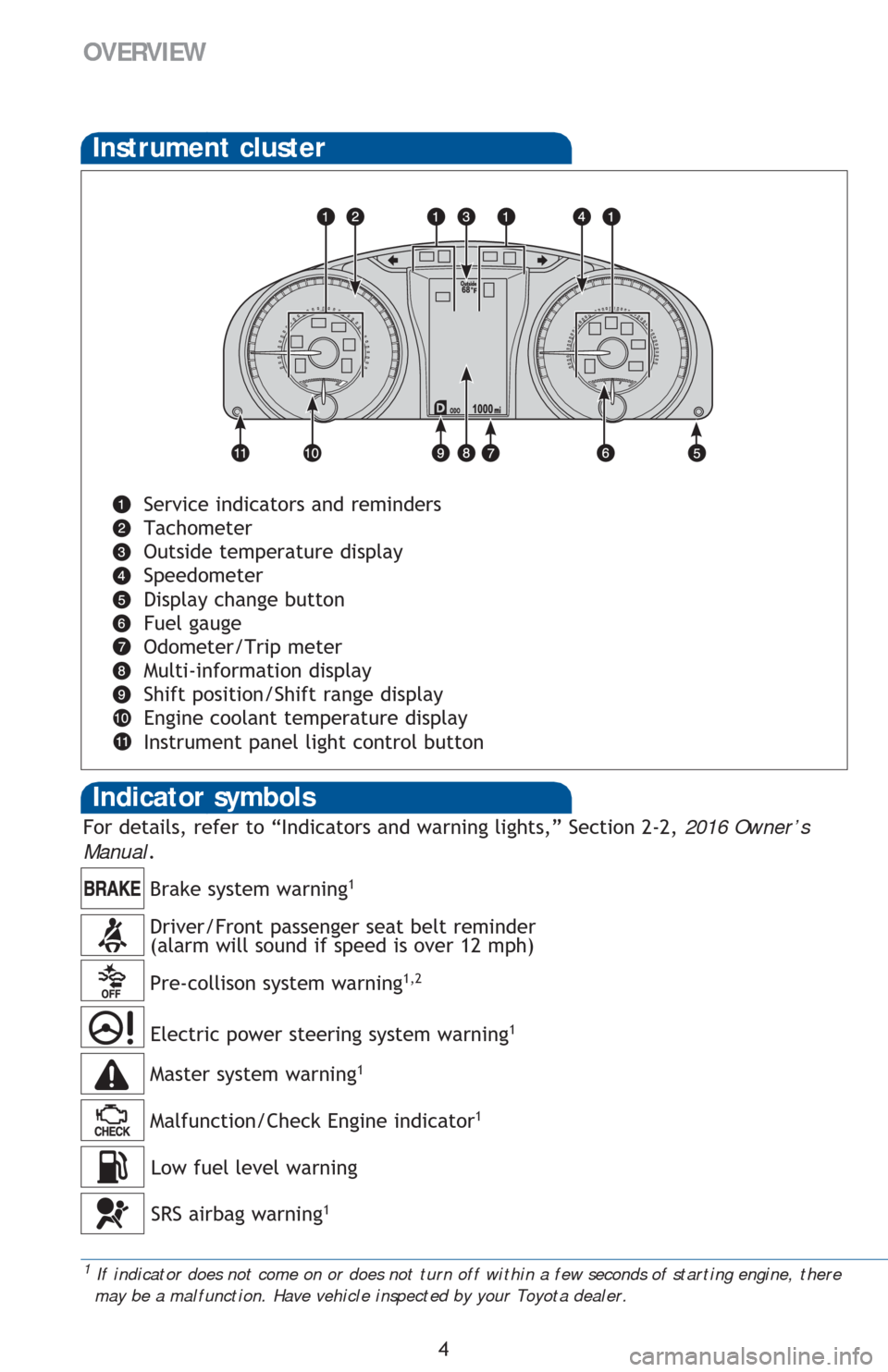
4
OVERVIEW
Instrument cluster
SRS airbag warning1
Electric power steering system warning1
Low fuel level warning
1 If indicator does not come on or does not turn off within a few seconds of starting engine, there
may be a malfunction. Have vehicle inspected by your Toyota dealer.
Service indicators and reminders
Tachometer
Outside temperature display
Speedometer
Display change button
Fuel gauge
Odometer/Trip meter
Multi-information display
Shift position/Shift range display
Engine coolant temperature display
Instrument panel light control button
Driver/Front passenger seat belt reminder
(alarm will sound if speed is over 12 mph)
Indicator symbols
Brake system warning1
For details, refer to “Indicators and warning lights,” Section 2-2, 2016 Owner’s
Manual.
Pre-collison system warning1,2
Malfunction/Check Engine indicator1
Master system warning1
Page 7 of 48
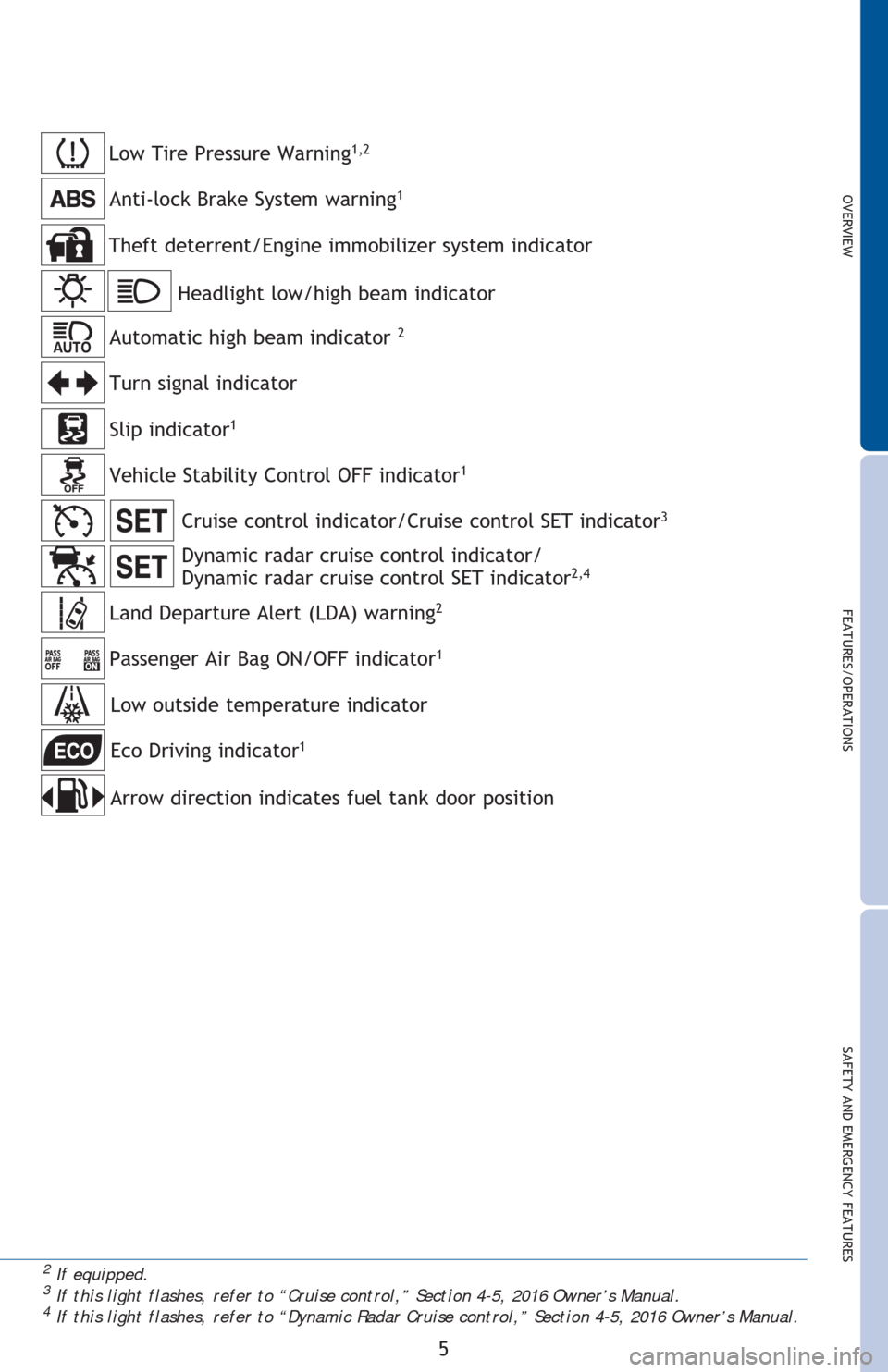
OVERVIEW
FEATURES/OPERATIONS
SAFETY AND EMERGENCY FEATURES
5
2 If equipped.3 If this light flashes, refer to “Cruise control,” Section 4-5, 2016 Owner’s Manual. 4 If this light flashes, refer to “Dynamic Radar Cruise control,” Section 4-5, 2016 Owner’s Manual.
Headlight low/high beam indicator
Turn signal indicator
Slip indicator1
Cruise control indicator/Cruise control SET indicator3
Dynamic radar cruise control indicator/
Dynamic radar cruise control SET indicator2,4
Low Tire Pressure Warning1,2
Theft deterrent/Engine immobilizer system indicator
Low outside temperature indicator
Anti-lock Brake System warning1
Vehicle Stability Control OFF indicator1
Eco Driving indicator1
Automatic high beam indicator 2
Land Departure Alert (LDA) warning2
Passenger Air Bag ON/OFF indicator1
Arrow direction indicates fuel tank door position
Page 9 of 48
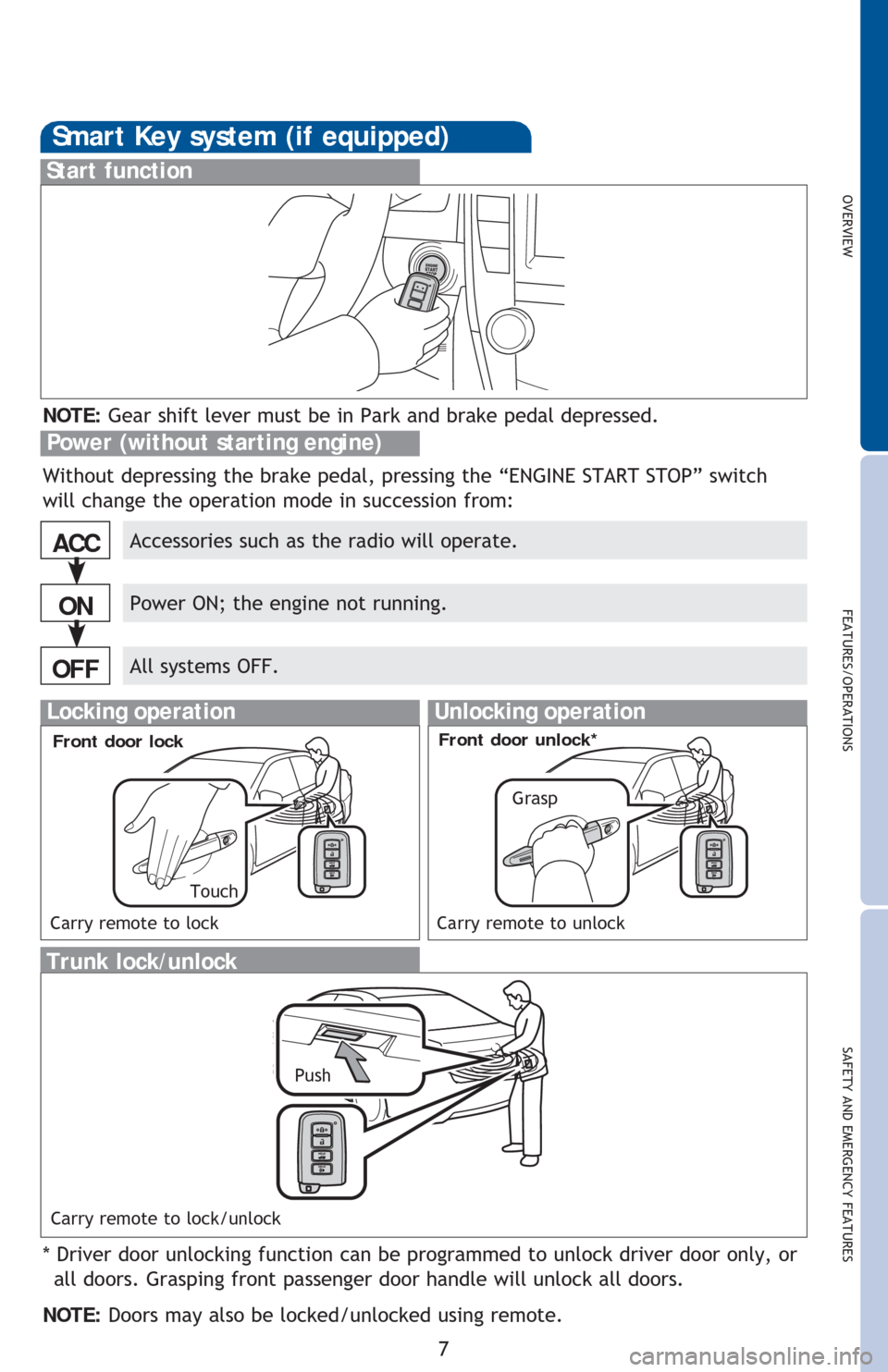
OVERVIEW
FEATURES/OPERATIONS
SAFETY AND EMERGENCY FEATURES
7
Smart Key system (if equipped)
Start function
Accessories such as the radio will operate.
Power ON; the engine not running.
All systems OFF.
ACC
ON
OFF
NOTE: Gear shift lever must be in Park and brake pedal depressed.
Without depressing the brake pedal, pressing the “ENGINE START STOP” switch
will change the operation mode in succession from:
* Driver door unlocking function can be programmed to unlock driver door only, or
all doors. Grasping front passenger door handle will unlock all doors.
NOTE: Doors may also be locked/unlocked using remote.
Power (without starting engine)
Trunk lock/unlock
Push
Locking operationUnlocking operation
Carry remote to lock Carry remote to unlock
Front door lock
Carry remote to lock/unlock
Front door unlock*
TouchGrasp
Page 10 of 48
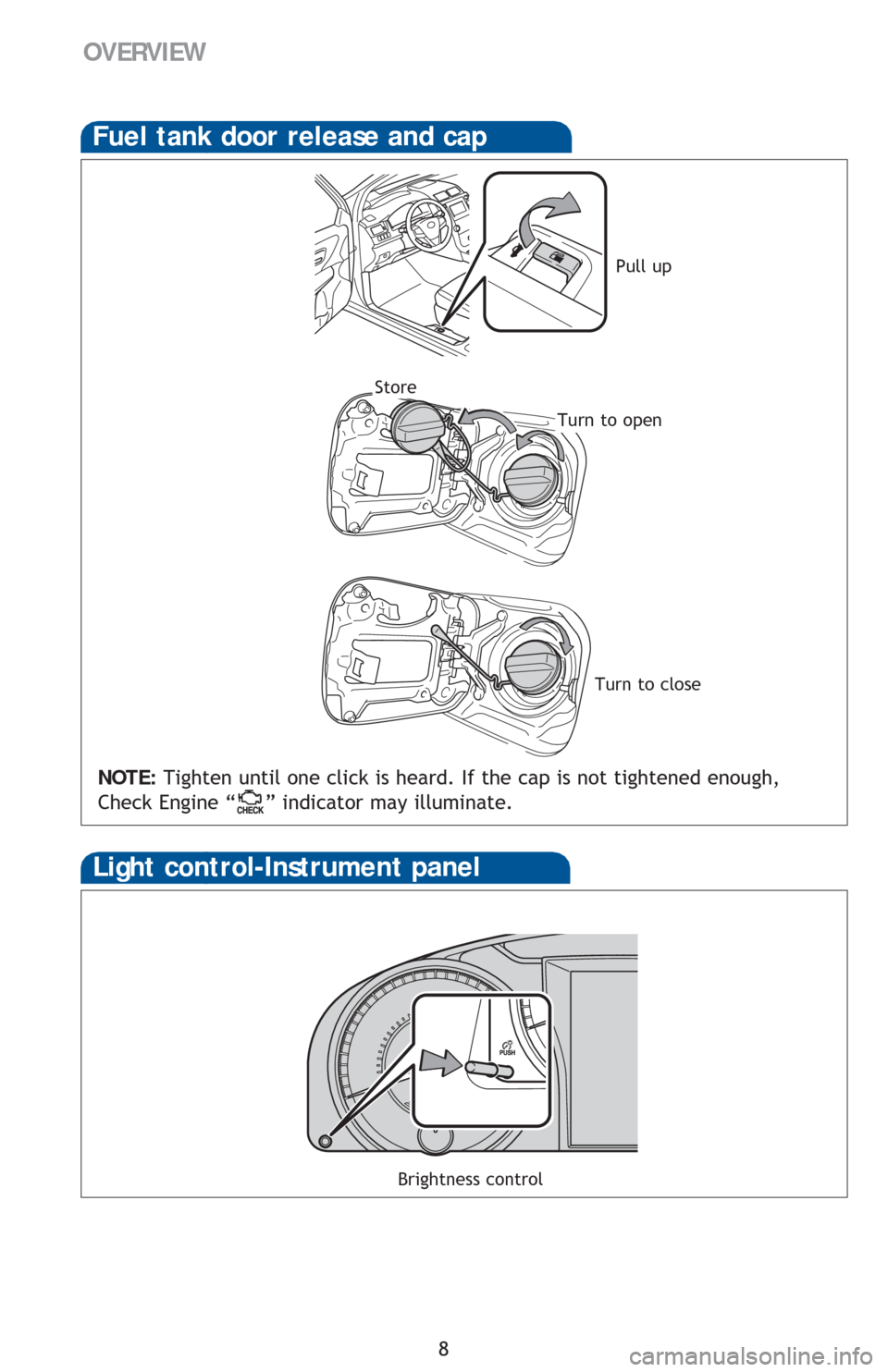
8
Fuel tank door release and cap
NOTE: Tighten until one click is heard. If the cap is not tightened enough,
Check Engine “
” indicator may illuminate.
Pull up
Turn to open
Store
Light control-Instrument panel
OVERVIEW
Brightness control
Turn to close
Page 11 of 48
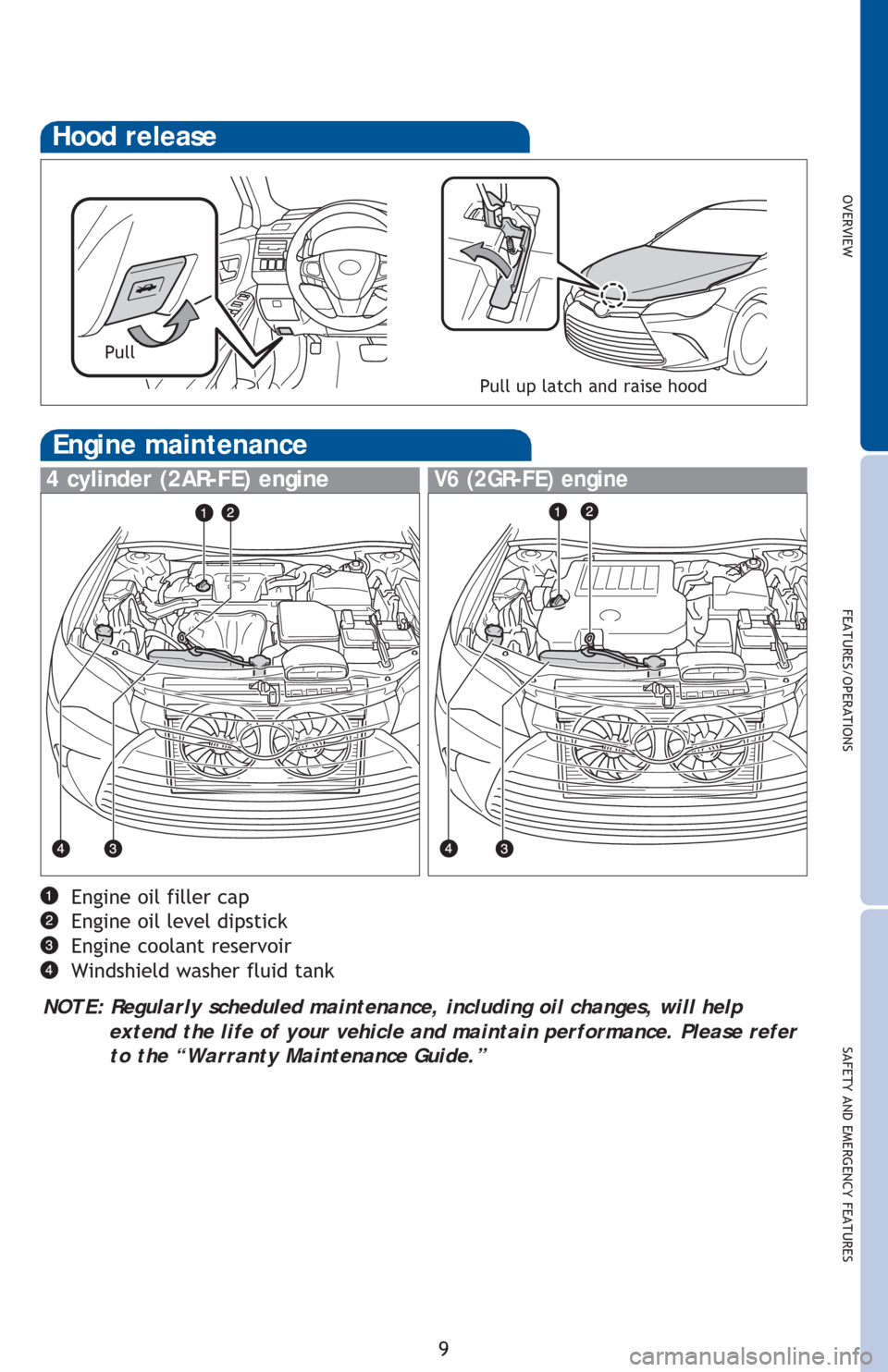
OVERVIEW
FEATURES/OPERATIONS
SAFETY AND EMERGENCY FEATURES
9
Hood release
Pull up latch and raise hood
Pull
Engine oil filler cap
Engine oil level dipstick
Engine coolant reservoir
Windshield washer fluid tank
NOTE: Regularly scheduled maintenance, including oil changes, will help
extend the life of your vehicle and maintain performance. Please refer
to the “Warranty Maintenance Guide.”
Engine maintenance
4 cylinder (2AR-FE) engineV6 (2GR-FE) engine
Page 12 of 48
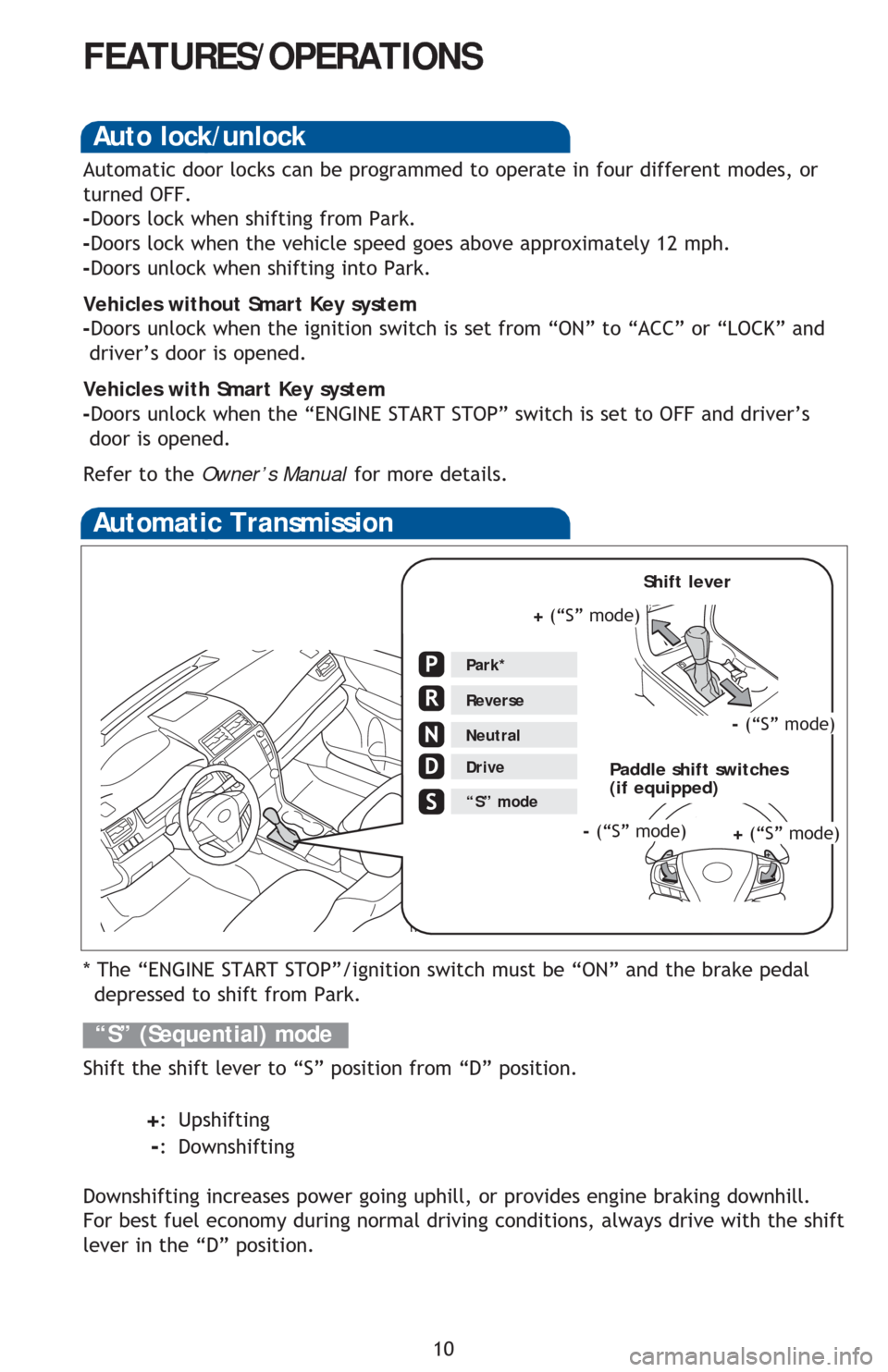
10
FEATURES/OPERATIONS
Automatic Transmission
* The “ENGINE START STOP”/ignition switch must be “ON” and the brake pedal
depressed to shift from Park.
Shift the shift lever to “S” position from “D” position.
+: Upshifting
-: Downshifting
Downshifting increases power going uphill, or provides engine braking downhill.
For best fuel economy during normal driving conditions, always drive with the shift
lever in the “D” position.
“S” (Sequential) mode
Park*
Reverse
Neutral
Drive
N
Page 16 of 48
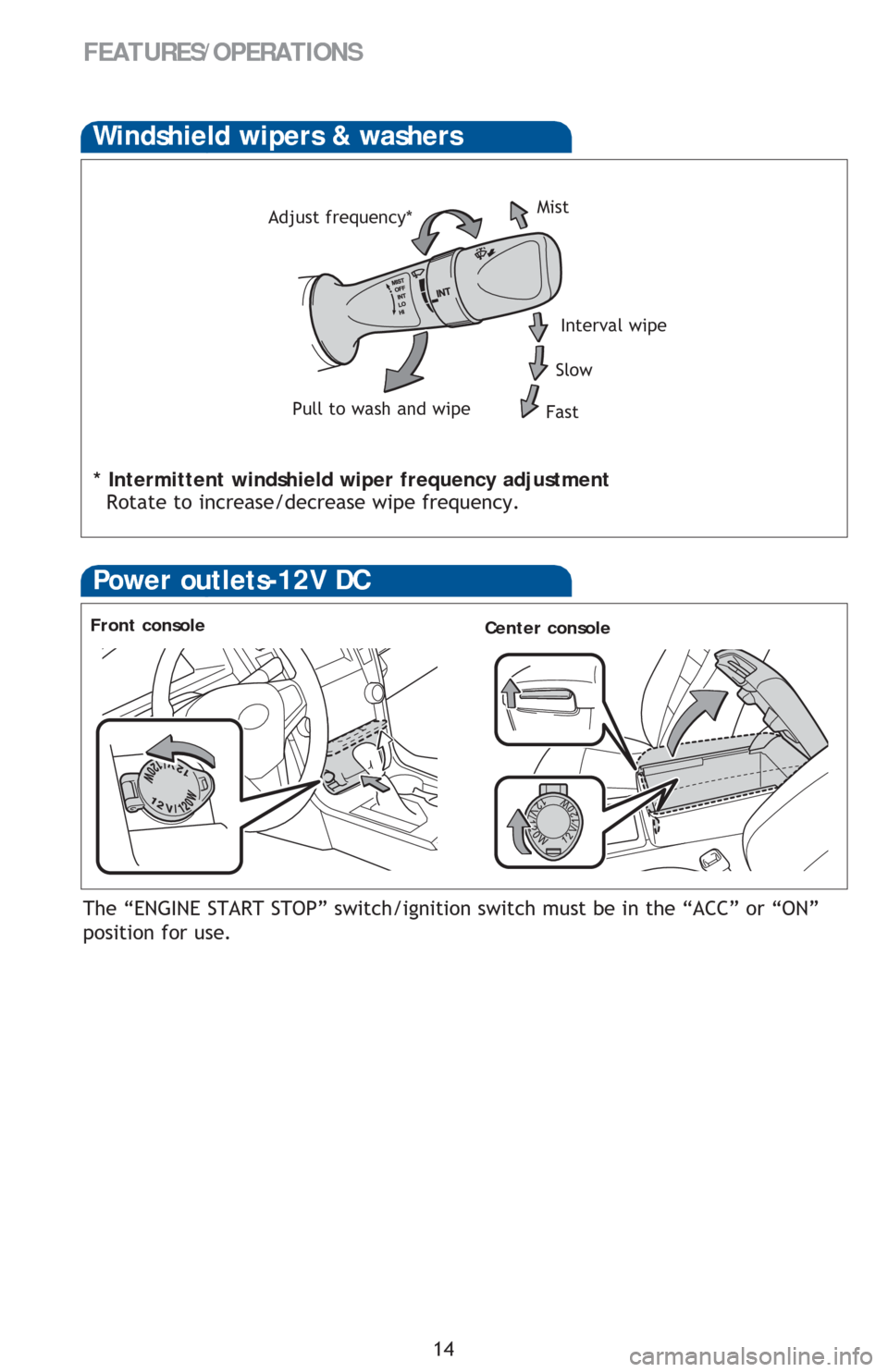
14
Power outlets-12V DC
Front console
The “ENGINE START STOP” switch/ignition switch must be in the “ACC” or “ON”
position for use.
Center console
Windshield wipers & washers
Adjust frequency*
Pull to wash and wipeMist
Interval wipe
Slow
Fast
FEATURES/OPERATIONS
* Intermittent windshield wiper frequency adjustment
Rotate to increase/decrease wipe frequency.
Page 31 of 48
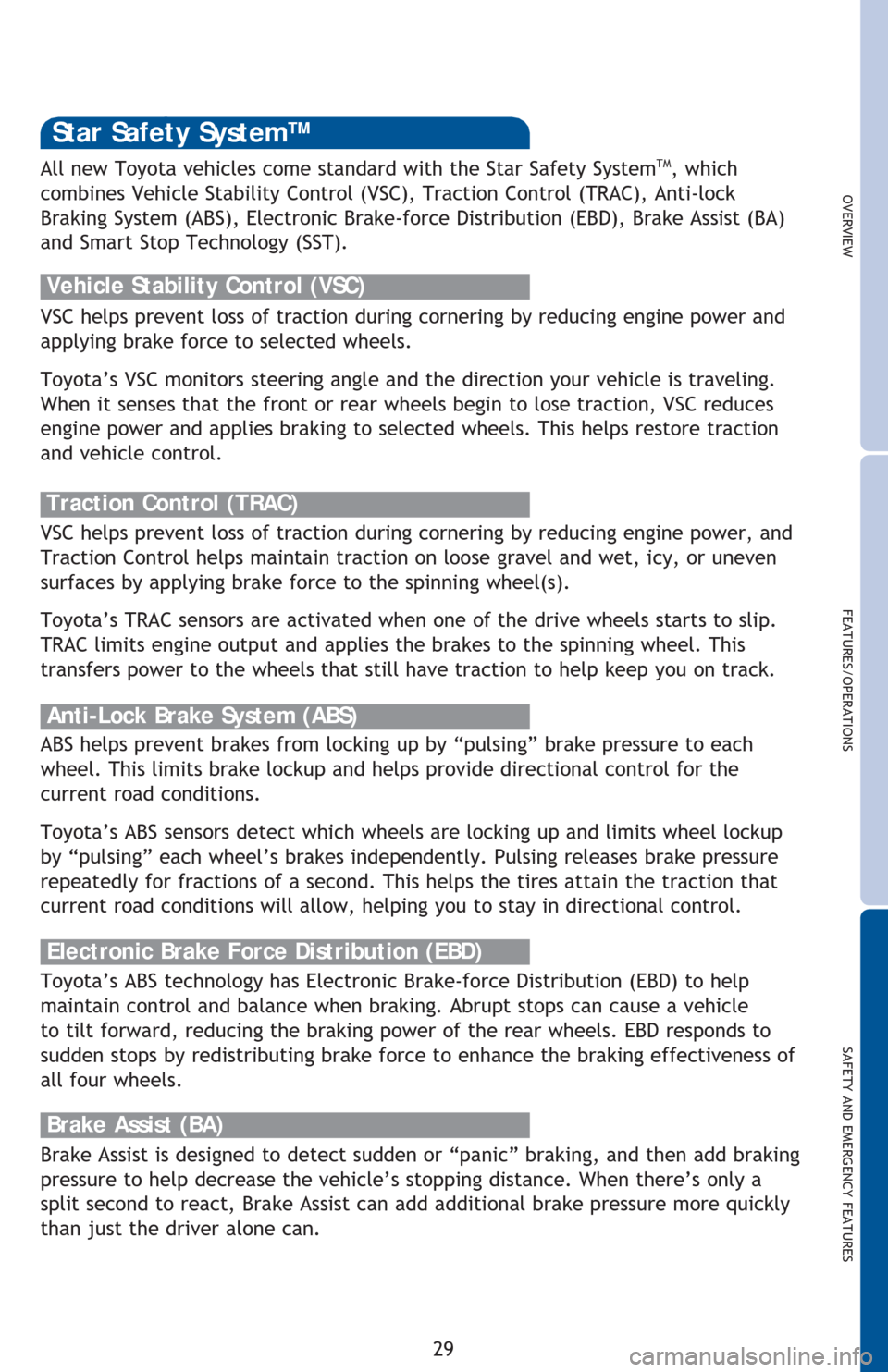
OVERVIEW
FEATURES/OPERATIONS
SAFETY AND EMERGENCY FEATURES
29
Star Safety SystemTM
VSC helps prevent loss of traction during cornering by reducing engine power and
applying brake force to selected wheels.
Toyota’s VSC monitors steering angle and the direction your vehicle is traveling.
When it senses that the front or rear wheels begin to lose traction, VSC reduces
engine power and applies braking to selected wheels. This helps restore traction
and vehicle control.
Vehicle Stability Control (VSC)
Anti-Lock Brake System (ABS)
ABS helps prevent brakes from locking up by “pulsing” brake pressure to each
wheel. This limits brake lockup and helps provide directional control for the
current road conditions.
Toyota’s ABS sensors detect which wheels are locking up and limits wheel lockup
by “pulsing” each wheel’s brakes independently. Pulsing releases brake pressure
repeatedly for fractions of a second. This helps the tires attain the traction that
current road conditions will allow, helping you to stay in directional control.
Brake Assist (BA)
Brake Assist is designed to detect sudden or “panic” braking, and then add braking
pressure to help decrease the vehicle’s stopping distance. When there’s only a
split second to react, Brake Assist can add additional brake pressure more quickly
than just the driver alone can. VSC helps prevent loss of traction during cornering by reducing engine power, and
Traction Control helps maintain traction on loose gravel and wet, icy, or uneven
surfaces by applying brake force to the spinning wheel(s).
Toyota’s TRAC sensors are activated when one of the drive wheels starts to slip.
TRAC limits engine output and applies the brakes to the spinning wheel. This
transfers power to the wheels that still have traction to help keep you on track.
Traction Control (TRAC)
Electronic Brake Force Distribution (EBD)
Toyota’s ABS technology has Electronic Brake-force Distribution (EBD) to help
maintain control and balance when braking. Abrupt stops can cause a vehicle
to tilt forward, reducing the braking power of the rear wheels. EBD responds to
sudden stops by redistributing brake force to enhance the braking effectiveness of
all four wheels. All new Toyota vehicles come standard with the Star Safety System
TM, which
combines Vehicle Stability Control (VSC), Traction Control (TRAC), Anti-lock
Braking System (ABS), Electronic Brake-force Distribution (EBD), Brake Assist (BA)
and Smart Stop Technology (SST).